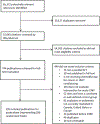Interventions for the prevention of acute phase chemotherapy-induced nausea and vomiting in adult and pediatric patients: a systematic review and meta-analysis
- PMID: 35953731
- PMCID: PMC10153509
- DOI: 10.1007/s00520-022-07287-w
Interventions for the prevention of acute phase chemotherapy-induced nausea and vomiting in adult and pediatric patients: a systematic review and meta-analysis
Abstract
Purpose: To identify effective and safe interventions to prevent acute phase chemotherapy-induced nausea and vomiting (CINV) in adult and pediatric patients.
Methods: We conducted a systematic review of randomized trials evaluating interventions to prevent acute CINV. Outcomes assessed were complete chemotherapy-induced vomiting (CIV) control, complete chemotherapy-induced nausea (CIN) control, complete CINV control, and discontinuation of antiemetics due to adverse effects.
Results: The search identified 65,172 citations; 744 were evaluated at full-text, and 295 (25 pediatric) met eligibility criteria. In patients receiving highly emetogenic chemotherapy (HEC), complete CIV (risk ratio (RR) 1.23, 95% confidence interval (CI) 1.05-1.44) and CIN (RR 1.34, 95% CI 1.10-1.62) control improved when olanzapine was added. The addition of a neurokinin-1 receptor antagonist (NK1RA) to a corticosteroid plus a serotonin-3 receptor antagonist (5HT3RA) also improved complete CIV (RR 1.11, 95% CI 1.08-1.14) and CIN (RR 1.05, 95% CI 1.01-1.08) control. Compared to granisetron/ondansetron, palonosetron provided improved complete CIV control when the 5HT3RA was given alone or when combined with dexamethasone. In patients receiving moderately emetogenic chemotherapy (MEC), dexamethasone plus a 5HT3RA improved complete CIV control compared to a 5HT3RA alone (RR 1.29, 95% CI 1.21-1.39). Only a single meta-analysis evaluating the safety outcome was possible.
Conclusions: For patients receiving HEC, various antiemetic regimens improved CIV and CIN control. For patients receiving MEC, administration of a 5HT3RA plus dexamethasone improved CIV control. Analysis of antiemetic safety was constrained by lack of data.
Keywords: Chemotherapy; Nausea; Pediatrics; Supportive care; Vomiting.
© 2022. The Author(s), under exclusive licence to Springer-Verlag GmbH Germany, part of Springer Nature.
Conflict of interest statement
Competing Interests
Financial interests: LLD has received grants from Heron Therapeutics for work outside of this clinical practice guideline. AO owns Pfizer stock.
No other author has relevant financial or non-financial interests to disclose.
References
-
- Sommariva S, Pongiglione B, and Tarricone R, Impact of chemotherapy-induced nausea and vomiting on health-related quality of life and resource utilization: a systematic review. Critical reviews in oncology/hematology, 2016. 99: p. 13–36. - PubMed
-
- Neymark N and Crott R, Impact of emesis on clinical and economic outcomes of cancer therapy with highly emetogenic chemotherapy regimens: a retrospective analysis of three clinical trials. Support Care Cancer, 2005. 13(10): p. 812–8. - PubMed
-
- Flank J, Sparavalo J, Vol H, et al., The burden of chemotherapy-induced nausea and vomiting in children receiving hematopoietic stem cell transplantation conditioning: a prospective study. Bone Marrow Transplant, 2017. 52(9): p. 1294–1299. - PubMed
Publication types
MeSH terms
Substances
Grants and funding
LinkOut - more resources
Full Text Sources
Medical
Miscellaneous


